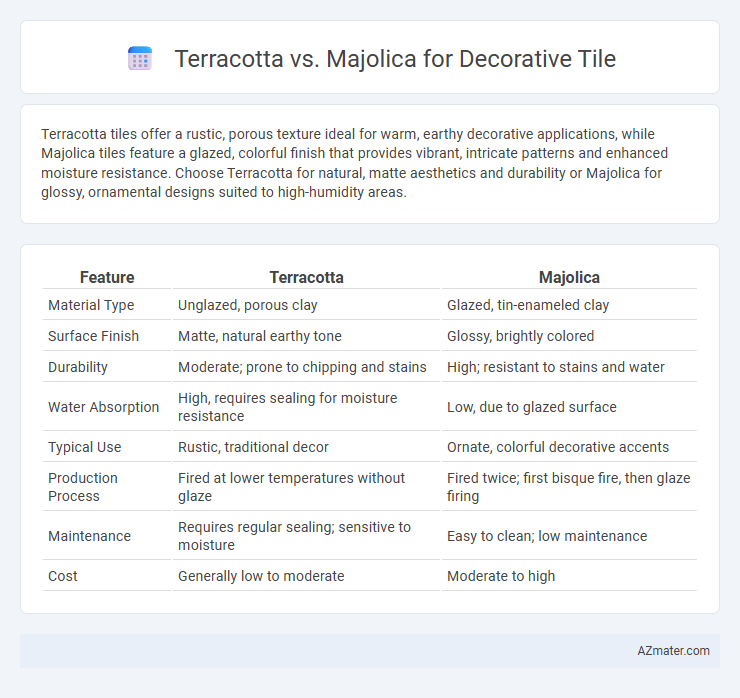Terracotta tiles offer a rustic, porous texture ideal for warm, earthy decorative applications, while Majolica tiles feature a glazed, colorful finish that provides vibrant, intricate patterns and enhanced moisture resistance. Choose Terracotta for natural, matte aesthetics and durability or Majolica for glossy, ornamental designs suited to high-humidity areas.
Table of Comparison
| Feature | Terracotta | Majolica |
|---|---|---|
| Material Type | Unglazed, porous clay | Glazed, tin-enameled clay |
| Surface Finish | Matte, natural earthy tone | Glossy, brightly colored |
| Durability | Moderate; prone to chipping and stains | High; resistant to stains and water |
| Water Absorption | High, requires sealing for moisture resistance | Low, due to glazed surface |
| Typical Use | Rustic, traditional decor | Ornate, colorful decorative accents |
| Production Process | Fired at lower temperatures without glaze | Fired twice; first bisque fire, then glaze firing |
| Maintenance | Requires regular sealing; sensitive to moisture | Easy to clean; low maintenance |
| Cost | Generally low to moderate | Moderate to high |
Introduction to Terracotta and Majolica Tiles
Terracotta tiles are crafted from natural clay, fired at low temperatures to achieve their characteristic earthy red hues and porous texture, making them ideal for rustic and Mediterranean-style decor. Majolica tiles feature a tin-glazed surface with vibrant, intricate patterns that provide both durability and a glossy finish, often used in traditional and ornate design schemes. Both materials offer distinctive aesthetic and functional qualities, with terracotta emphasizing organic warmth and majolica showcasing vivid, artistic expression.
Historical Origins and Cultural Significance
Terracotta, originating from ancient Mesopotamia and widely used in Roman and Etruscan architecture, is a porous, unglazed clay material celebrated for its earthy tones and durability in decorative tiles. Majolica, developed during the Italian Renaissance, features tin-glazed pottery with vibrant, intricate designs reflecting Mediterranean artistry and often symbolizes wealth and artistic expression. Both materials carry deep cultural significance, with terracotta representing organic, rustic heritage while majolica embodies ornate craftsmanship and historical refinement in tile decoration.
Material Composition and Manufacturing Process
Terracotta tiles are made from natural clay fired at lower temperatures, resulting in a porous, earthy material with a matte finish ideal for rustic or traditional decor. Majolica tiles consist of a terracotta base coated with a tin-based opaque glaze, then fired again at higher temperatures to create a glossy, colorful surface with intricate designs. The manufacturing process of terracotta emphasizes simplicity and raw texture, while majolica involves complex glazing techniques to achieve its vibrant, decorative appeal.
Visual Characteristics and Color Palette
Terracotta tiles offer warm, earthy tones ranging from deep reds to rich browns, characterized by their porous, matte finish and natural, rustic texture ideal for traditional or Mediterranean-inspired decor. Majolica tiles feature a vivid, glossy surface with intricate hand-painted designs often showcasing blues, greens, yellows, and whites, making them perfect for creating vibrant, eye-catching patterns. The contrast between terracotta's subdued, organic hues and majolica's bright, ornamental colors highlights their distinct visual appeal for decorative tile applications.
Durability and Maintenance Requirements
Terracotta tiles, made from natural clay fired at lower temperatures, offer rustic charm but are more porous and prone to chipping, requiring regular sealing to maintain durability. Majolica tiles, glazed with a vitreous coating, provide a harder, water-resistant surface that resists stains and scratching, making maintenance simpler and less frequent. For long-lasting decorative tile installations, majolica's enhanced durability and minimal upkeep often make it the preferred choice over terracotta.
Design Versatility and Application Areas
Terracotta tiles, crafted from natural clay, offer a warm, rustic aesthetic ideal for traditional and Mediterranean designs, excelling in outdoor patios, fireplaces, and garden pathways due to their durability and natural finish. Majolica tiles feature vibrant, hand-painted glazes on a white earthenware base, providing intricate patterns and bright colors perfect for accent walls, kitchen backsplashes, and decorative art pieces, enhancing spaces with a bold, artistic flair. The design versatility of terracotta emphasizes earthy textures and muted tones suited for expansive flooring, while majolica's vivid designs allow for creative, detail-oriented applications in both residential and commercial interiors.
Cost Comparison: Terracotta vs Majolica
Terracotta tiles generally offer a lower cost compared to Majolica due to their simpler production process and natural clay composition. Majolica tiles, often glazed and hand-painted, tend to have higher prices reflecting the intricate craftsmanship and vibrant designs. Budget-conscious projects favor Terracotta for affordability, while Majolica justifies its premium cost through decorative appeal and unique artistic value.
Eco-Friendliness and Sustainability Factors
Terracotta tiles, made from natural clay, boast low environmental impact due to minimal processing and the use of abundant raw materials, making them highly sustainable and biodegradable. Majolica tiles, featuring a tin-glazed surface, require more energy-intensive firing and chemical glazes, which can reduce eco-friendliness despite their durability. Both options offer long lifespan, but terracotta's simpler production and natural composition prioritize eco-conscious choices for decorative tiling projects.
Popular Styles and Modern Trends
Terracotta tiles, characterized by their warm earthy tones and rustic texture, remain popular in Mediterranean and Southwestern style designs, offering a natural, handcrafted appeal that complements organic interiors. Majolica tiles feature vibrant, colorful glazes and intricate patterns rooted in Italian and Spanish traditions, making them ideal for creating bold accent walls or backsplashes in contemporary eclectic and bohemian spaces. Modern trends favor combining terracotta's matte, neutral palette with Majolica's glossy, richly patterned surfaces to achieve dynamic contrast and layered visual interest in decorative tile installations.
Choosing the Right Tile for Your Project
Terracotta tiles offer a rustic, earthy aesthetic with excellent durability, making them ideal for outdoor patios and high-traffic areas that require a natural, warm look. Majolica tiles, characterized by their vibrant, glossy glaze and intricate patterns, suit decorative indoor spaces such as kitchens and bathrooms, adding a Mediterranean or vintage flair. Selecting the right tile depends on the project's exposure to elements, desired visual impact, and maintenance considerations, with terracotta favoring durability and majolica excelling in decorative detail.

Infographic: Terracotta vs Majolica for Decorative Tile
 azmater.com
azmater.com